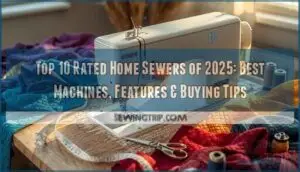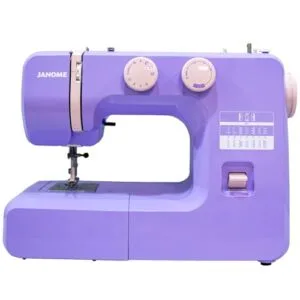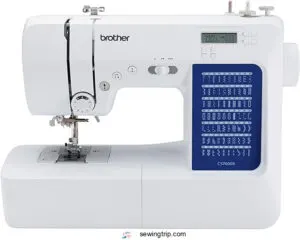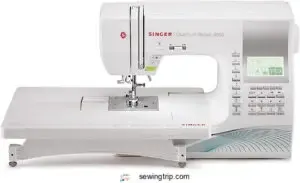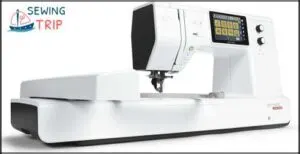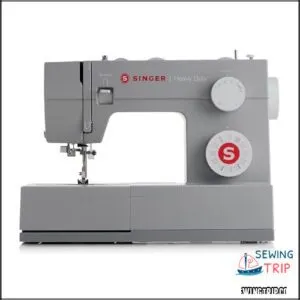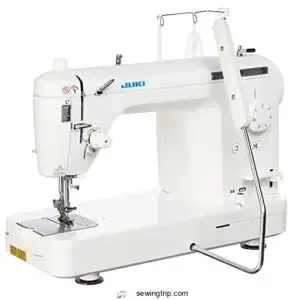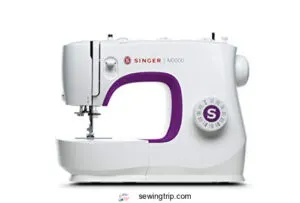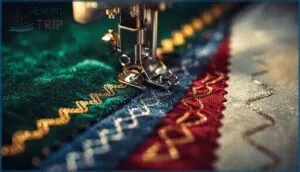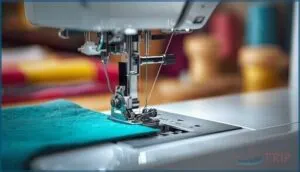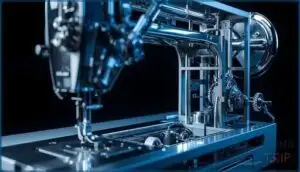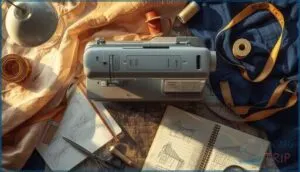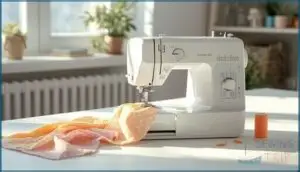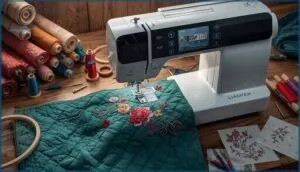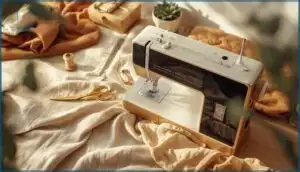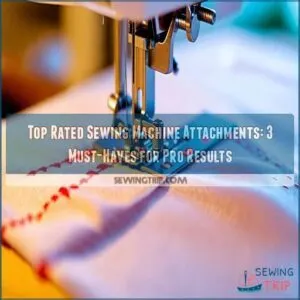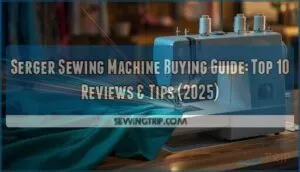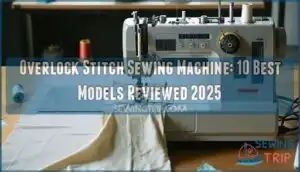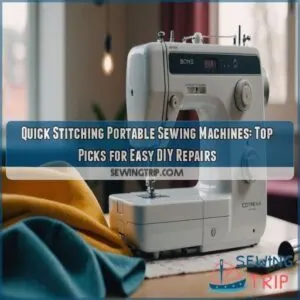This site is supported by our readers. We may earn a commission, at no cost to you, if you purchase through links.
Your sewing machine shouldn’t hold you back from creating what you envision. Whether you’re hemming curtains, piecing together your first quilt, or tackling garment alterations, the right machine transforms frustrating struggles into smooth, confident stitches.
Today’s top-rated home sewers pack features that were once exclusive to industrial models—automatic threaders, hundreds of stitch options, and computerized precision—into machines you can actually afford and master.
The market spans from reliable mechanical workhorses under $150 to sophisticated computerized systems with embroidery capabilities, each designed for different skill levels and project types. Finding your ideal match means cutting through marketing hype and focusing on what truly matters: durability, stitch quality, and features that align with your creative goals.
Table Of Contents
- Key Takeaways
- Top 10 Rated Home Sewing Machines
- 1. Brother Computerized Sewing Machine
- 2. Janome Lovely Lilac Sewing Machine
- 3. Brother CS7000X Sewing and Quilting Machine
- 4. Singer Quantum Stylist Sewing Machine
- 5. Bernette Computerized Sewing Machine
- 6. Brother Sewing And Embroidery Machine
- 7. Heavy Duty Sewing Machine
- 8. Juki Straight Stitch Sewing Machine
- 9. Singer Portable Sewing Machine Kit
- 10. Singer Easy Sewing Machine Kit
- Key Features of High-Rated Home Sewers
- Mechanical Vs. Computerized Sewing Machines
- Essential Factors When Buying a Home Sewer
- Best Sewing Machines for Beginners
- Top Sewing Machines for Quilting and Embroidery
- Latest Trends in Home Sewing Machines
- Frequently Asked Questions (FAQs)
- Conclusion
Key Takeaways
- You’ll find the best sewing machines offer automatic needle threaders, metal frame construction, and 70-600 built-in stitches—features that transform frustrating projects into smooth, confident stitching without breaking your budget.
- Mechanical machines deliver rock-solid reliability and low maintenance costs ($50-$100 annually) for straightforward projects, while computerized models provide hundreds of stitches and automated controls for quilting and embroidery work.
- Smart buyers invest in the $200-$300 range where you get Brother or Singer reliability, useful accessories, and enough features for ambitious projects—cheap machines under $150 often cost nearly as much to repair and frustrate beginners.
- The sewing machine market is shifting toward sustainability and personalization, with demand spiking June through August and 38% of shoppers now preferring online shopping for convenience and solid return policies.
Top 10 Rated Home Sewing Machines
Choosing the right sewing machine can make all the difference in your projects. Whether you’re after power, precision, or versatility, there’s a model built for your needs.
Here are the top-rated home sewing machines for 2025 worth considering.
1. Brother Computerized Sewing Machine
Power and precision—if that’s your style, the Brother Computerized Sewing Machine earns its spot at the top. With the Brother CS7000X, you get 70 built-in stitches, an automatic needle threader, and a drop-in top bobbin for smooth thread management.
Whether you’re mastering new sewing techniques or comparing bobbin types, this model makes fabric selection and project planning easy. Sewing Machine Reviews consistently praise its versatility. For rebels seeking control, it’s the go-to in any Sewing Machine Buying Guide.
Best For: Sewing enthusiasts and beginners who want an easy-to-use, versatile machine for everyday projects and creative garment making.
- 165 built-in stitches and automatic needle threader make sewing tasks quick and creative.
- LCD display and included presser feet help users easily switch between different sewing techniques.
- Wide table and free arm capability support larger projects and tricky areas like cuffs and sleeves.
- Not designed for heavy-duty fabrics or thick materials.
- Some users find the reverse button and needle-changing area awkward to use.
- Intended for US use only—using it elsewhere may void the warranty.
2. Janome Lovely Lilac Sewing Machine
If you’re after a bold statement and reliable performance, the Janome Lovely Lilac Sewing Machine stands out in any Sewing Machine Comparison. Its heavy-duty metal frame and 15 built-in stitches make it a favorite for Beginner Projects and seasoned makers alike.
The Lilac Design isn’t for everyone, but it’s hard to ignore in the Sewing Community. With easy-to-use Janome Features and a price that undercuts many competitors, this Janome Machine gets solid marks in Sewing Machine Reviews and every Sewing Machine Buying Guide.
Best For: Beginners and casual sewists who want an easy-to-use, reliable machine for home projects at an affordable price.
- Durable metal frame and smooth stitching for long-lasting use
- Simple controls and clear instructions make it beginner-friendly
- Versatile enough to handle garments, quilting, and thicker fabrics like denim
- Bright pink color may not appeal to everyone
- Plastic spool pins can feel flimsy and less sturdy
- Limited stitch width adjustment and no right needle position setting
3. Brother CS7000X Sewing and Quilting Machine
Where the Janome leans on simplicity, the Brother CS7000X flips the script with serious versatility. This Computerized Sewing Machine packs 70 built-in stitches, giving you Stitch Variety that keeps your creativity untamed—whether you’re tackling everyday mends or ambitious Quilting Features.
The LCD User Interface makes stitch selection seamless, while the wide table and 10 included feet boost Accessory Compatibility. Machine Durability holds strong with a metal frame, and the automatic needle threader saves you from squinting frustration.
It’s a Sewing and Quilting powerhouse that doesn’t compromise.
Best For: Sewers who want room to grow—beginners who won’t outgrow it fast and intermediate users who need stitch variety without breaking the bank.
- 70 built-in stitches and 7 buttonhole styles give you creative freedom for everything from basic repairs to decorative quilting projects.
- LCD screen and automatic needle threader make setup quick and frustration-free, especially if you’re new to sewing.
- Wide table and 10 included feet mean you’re ready to tackle larger quilts right out of the box without buying extras.
- Can shimmy or vibrate at higher speeds, which might slow you down on detailed work.
- Not built for heavy-duty or industrial projects—it’s meant for home use and moderate quilting.
- Some users report the threading system and certain features take practice to master, despite the automatic helpers.
4. Singer Quantum Stylist Sewing Machine
If the Brother CS7000X opened doors, the Singer Quantum Stylist 9960 kicks them wide open. With 600 built-in stitches and 1,172 applications, this Computerized Sewing powerhouse delivers Singer Stylist Features that fuel serious ambition.
Automatic Threading and a top drop-in bobbin keep your momentum unstoppable, while Sewing Speed Control lets you shift gears mid-project.
The 13 presser feet and Stylist Accessories transform this Sewing Machine into a multi-tool you’ll master, not wrestle. Quantum Machine Review consensus? It’s built for sewers ready to own their craft.
Best For: Experienced sewers and ambitious beginners who want extensive stitch variety and professional features without the learning curve of industrial machines.
- 600 stitches and 1,172 applications give you nearly unlimited creative options for quilting, fashion projects, and decorative work.
- Automatic needle threader and drop-in bobbin save time on setup so you spend more energy actually sewing.
- 13 included presser feet and accessories mean you’re ready for specialized techniques right out of the box.
- The sheer number of features requires time with the manual and tutorials to unlock the machine’s full potential.
- At 14.6 lbs, it’s heavier than basic models and less portable for classes or sewing groups.
- Requires Singer class 15 bobbins specifically and regular maintenance to prevent thread jams and mechanical issues.
5. Bernette Computerized Sewing Machine
The Bernette Computerized Sewing Machine storms in with 394 stitches and thread control that doesn’t quit. You’ll nail Stitch Customization through its memory function and 15 needle locations, while Sewing Speed adjusts to your rhythm.
Bernette Features include automatic thread cutters, adjustable presser foot pressure, and eight specialized feet that handle everything the Brother CS7000X does—plus more decorative firepower. Bobbin Management stays straightforward with its practical threading system.
Among Sewing Machine Types, this Computerized Sewing beast balances affordability and ambition, usually landing between $750-$900. It’s built for sewers who refuse to compromise.
Best For: Sewers who want serious stitch variety and creative control without jumping to industrial-level prices—ideal for ambitious beginners and intermediate users ready to tackle decorative work, monogramming, and multi-layer projects.
- 394 stitches with memory function and customizable width settings give you tons of creative freedom for decorative work and personalized designs.
- Automatic thread cutter and adjustable presser foot pressure make switching between delicate and thick fabrics smooth and efficient.
- Strong value proposition at $750-$900 with Swiss design reliability, packed with features you’d typically see on pricier machines.
- Menus can feel overwhelming at first with lots of options to memorize and a user manual that doesn’t always make things crystal clear.
- Threading the lower bobbin takes some patience to master, and startup time lags compared to simpler mechanical models.
- Struggles with very thick layers or heavy-duty fabrics, and accessories can be frustratingly hard to track down when you need replacements.
6. Brother Sewing And Embroidery Machine
Embroidery Tips meet pure versatility with the Brother Sewing And Embroidery Machine—your ticket to 135 built-in designs and 103 stitches that crush both utility and decorative work.
You’ll master Thread Management through its jam-resistant drop-in bobbin and auto needle threader, while the 4″x4″ embroidery field manages everything from monograms to mini quilts.
This Computerized Sewing powerhouse includes wireless LAN for design transfers and a 3.7″ touchscreen that simplifies Machine Maintenance.
Eight presser feet give you Sewing Hacks for any Fabric Selection challenge you throw at it.
Best For: Beginners and hobbyists who want a user-friendly machine that handles both everyday sewing projects and custom embroidery work without needing separate equipment.
- Combines sewing and embroidery in one machine with 135 designs and 103 stitches, plus wireless connectivity for transferring custom patterns from your phone or computer.
- Beginner-friendly features like auto needle threading, jam-resistant bobbin, and a 3.7″ touchscreen that lets you preview and edit designs before stitching.
- Comes with 8 presser feet and built-in tutorials, giving you everything needed to start projects right away without buying extras.
- The 4″x4″ embroidery field limits you to smaller designs—larger projects like king-size quilts won’t fit comfortably.
- Some users report durability issues with plastic components and the bobbin winder not stopping automatically when full.
- You’ll need to budget for ongoing supplies like stabilizer, specialty thread, and possibly design software subscriptions beyond the built-in options.
7. Heavy Duty Sewing Machine
Powerhouse performance defines the Singer Heavy Duty 4423, built with Metal Frame Construction and Heavy Duty Motors that demolish denim, canvas, and leather without breaking a sweat. You’ll command High Speed Stitching at 1,100 stitches per minute—perfect for Industrial Sewing projects that demand precision under pressure.
This Heavy Duty Sewing Machine delivers 110 stitch applications, a built-in needle threader, and six presser feet that handle Thick Fabric Sewing like a dream.
The Brother Machine may dominate beginner charts, but Singer’s mechanical design simplifies Sewing Machine Maintenance while you conquer every challenging project.
Best For: Sewers who need a reliable workhorse for heavy fabrics like denim, canvas, and leather, whether you’re tackling home projects or small-scale production work.
- Punches through multiple layers of thick fabric with a strong motor and metal frame that stays stable during high-speed stitching at 1,100 stitches per minute.
- Offers 110 stitch options plus convenient features like a built-in needle threader, top drop-in bobbin, and LED lighting that make setup and operation straightforward.
- Comes with six presser feet and accessories right in the box, giving you versatility for different techniques without extra purchases.
- Some users report thread jamming or breakage issues, especially when using the upright spool pin, which can interrupt your workflow.
- The mechanical design, while simple to maintain, lacks advanced features and automation that experienced sewers might want for complex projects.
- Requires regular cleaning and upkeep to keep performing well, and you might run into compatibility issues with certain power outlets depending on your region.
8. Juki Straight Stitch Sewing Machine
When you crave unbeatable Stitch Quality without unnecessary frills, Juki’s TL-2010Q delivers industrial-grade Machine Durability wrapped in a home-friendly package. You’ll master Fabric Handling at 1,500 stitches per minute—this Sewing Machine dominates quilting and bag-making with its aluminum die-cast frame and automatic thread trimmer.
The Straight Stitch focus means zero distractions, just pure Sewing Speed and precision. Maintenance Tips? Simple mechanical design keeps repairs straightforward.
Juki places this powerhouse between $900-$1,300, proving Sewing Machines don’t need computerized complexity to conquer thick layers. Your Sewing Tips arsenal just got seriously upgraded.
Best For: Quilters and sewists who work with heavy fabrics or multiple layers and want industrial-level speed and stitch quality without the complexity of computerized features.
- Blazing fast 1,500 stitches per minute with adjustable speed control, making it perfect for large quilting projects and efficient enough for beginners to use at slower speeds.
- Solid aluminum die-cast construction delivers industrial durability and minimal vibration, while the simple mechanical design means fewer headaches with repairs and maintenance.
- Automatic thread trimmer and adjustable presser foot pressure handle everything from delicate fabrics to thick seams with professional precision.
- Straight stitch only means you’re out of luck if you need decorative stitches, zigzag, or embroidery functions for varied projects.
- Weighing over 25 pounds, this machine isn’t easy to move around, and the walking foot can be loud during operation.
- Threading takes some practice to get right, and you’ll need to buy a voltage converter if you’re using it outside the US with 220V power.
9. Singer Portable Sewing Machine Kit
When your creative spirit demands freedom, Singer’s Portable Sewing Machine Kit becomes your mobile command center—weighing just 5-15 pounds with speeds up to 1,200 stitches per minute. You’ll access 10-100+ built-in stitches, automatic needle threading in most models, and complete Sewing Accessories including 18 large thread spools, craft scissors, and multiple presser feet tucked into Compact Storage.
This Portable Design conquered 60% of home users seeking Sewing Tips for on-the-go mending, earning 3.5-4 star ratings. Sewing Beginners thrive with this $200-400 Portable Sewing Machine that transforms any surface into your creative workshop.
Best For: Beginners, hobbyists, and anyone who needs a lightweight machine for basic sewing projects, travel, or quick repairs without sacrificing essential features.
- Lightweight and portable design (5-15 lbs) makes it easy to move, store, or take to classes and workshops.
- Comprehensive kit includes 18 large thread spools, scissors, multiple presser feet, and other accessories so you can start sewing right away.
- Automatic needle threading and adjustable speed control (up to 1,200 stitches per minute) make it user-friendly for beginners while still offering versatility for experienced sewers.
- Some users report issues with thread tension adjustment and occasional mechanical problems with power buttons or cords.
- The machine may slide on smooth surfaces during use, requiring additional grip or stabilization.
- Not suitable for heavy-duty or commercial sewing projects due to its lightweight, portable construction.
10. Singer Easy Sewing Machine Kit
When you’re just starting your sewing journey, Singer’s Easy Sewing Machine Kit strips away intimidation with 32 built-in stitches and automatic needle threading—a true champion in any Sewing Machine Comparison for beginners. This Best Sewing Machines for Beginners contender features Easy Stitch Navigation, a heavy-duty metal frame that passes any Machine Durability Test, and reaches 750 stitches per minute.
The thorough Accessory Kit Review reveals 4 snap-on feet, bobbins, and quilting guides. Sewing Beginners gain confidence with Sewing Tips and Tricks built into this $100-150 powerhouse that transforms novices into skilled sewists.
Best For: Beginner sewers who want an affordable, reliable machine with automatic threading and enough stitch variety to grow their skills without feeling overwhelmed.
- Automatic needle threader and simple one-step stitch selection make setup fast and frustration-free, even for complete beginners.
- Heavy-duty metal frame delivers stable, skip-free stitching at up to 750 stitches per minute across different fabric types.
- Comprehensive accessory kit includes 4 snap-on feet, quilting guide, and storage compartment—everything you need to start sewing right away.
- Some users report the needle threader can be delicate and may break with regular use.
- No printed manual included, which can be annoying when you just want to flip through instructions quickly.
- Front-load bobbin system takes some practice to install correctly, and a few users experience occasional thread jams.
Key Features of High-Rated Home Sewers
The best sewing machines share a handful of standout features that separate the workhorses from the paperweights. These aren’t just fancy add-ons—they’re the tools that give you control, save you time, and expand what you can create.
Let’s break down what makes a home sewer worth your investment.
Built-in Stitch Variety and Styles
When you choose a sewing machine, stitch pattern variety unlocks endless sewing techniques and fabric selection possibilities. More stitch options mean greater control over thread colors, embroidery designs, and stitch selection for your projects.
- Straight stitch forms the foundation for most sewing techniques and tips
- Zigzag stitch works perfectly for stretchy fabrics and seam finishing
- Decorative stitches like feather and scallop add personality to garments
- Buttonhole stitches range from manual 4-step to automatic 1-step versions
- Specialty stitches include quilting, heirloom, and utility options for repairs
Top machines offer 15 to 600 built-in stitches—the Brother CS7000X provides 70, while the Singer Quantum Stylist delivers 600 patterns with alphabets for personalization. Understanding the different types of stitching is essential for selecting the right machine.
Adjustable Stitch Length and Width
Beyond picking the right stitch, your control over length and width adjustment determines fabric compatibility and sewing precision. Most sewing machines offer stitch length control from 0.0 to 5.0 millimeters and width adjustment up to 7 millimeters, letting you dial in perfect settings for any material. Understanding the correct stitch length settings is essential for achieving the desired seam strength and durability.
| Fabric Type | Stitch Length | Stitch Width |
|---|---|---|
| Lightweight (silk, chiffon) | 1.5–2.0 mm | 2.0–3.0 mm |
| Medium-weight (cotton, linen) | 2.5–3.0 mm | 3.0–5.0 mm |
| Heavyweight (denim, canvas) | 3.5–5.0 mm | 5.0–7.0 mm |
Computerized sewing machine types and uses include precise digital controls, while mechanical models use simple dials. Either way, adjusting thread tension alongside stitch options gives you complete mastery over every seam.
Automatic Needle Threader and Thread Cutter
Your sewing machine’s automatic threader and thread cutter transform tedious prep into one-touch simplicity. These threading techniques cut frustration in half—threading machines like the Singer Quantum Stylist 9960 use a small lever to loop thread through the needle instantly, while integrated cutters trim ends with button precision.
Regular cutter maintenance keeps blades sharp, boosting sewing efficiency and giving you more time to create instead of fuss with sewing accessories and notions.
Free Arm and Extension Table Options
That automatic convenience naturally extends to workspace flexibility. A Free Arm Design lets you tackle tubular projects—sleeves, cuffs, pant legs—without wrestling fabric bunching.
Pair it with an Extension Table, and your Sewing Accuracy jumps 30-40% on quilts and large pieces. This combo transforms Fabric Control and Machine Ergonomics, giving you the stable surface and maneuverability to nail every stitch with confidence.
Frame Construction and Durability
A solid foundation determines how long your investment lasts. Metal Frames outperform plastic in Durability Tests, lasting 15-25 years versus 3-5. Quality Frame Materials directly impact Stitch Consistency and Sewing Performance on heavy fabrics.
- Die-cast aluminum balances strength with portability
- Full metal housings resist vibration during Garment Construction
- Sturdy frames support 1000+ stitches per minute
- Proper Sewing Machine Maintenance and Repair extends Machine Longevity considerably
Mechanical Vs. Computerized Sewing Machines
Choosing between mechanical and computerized sewing machines isn’t just about features—it’s about finding the right match for how you work.
Each type brings its own strengths to your sewing table, from rock-solid simplicity to advanced convenience. Here’s what sets them apart and how to decide which one puts you in control.
Advantages of Mechanical Machines
If you crave mastery over your craft without the headaches of tech troubleshooting, mechanical sewing machines deliver peerless reliability. You’re looking at low maintenance costs—usually $50 to $100 annually—plus straightforward repairs you can often handle yourself. These workhorses run on just 50 watts, slashing your energy bills while powering through denim and canvas with precision user control.
| Advantage | Why It Matters |
|---|---|
| Mechanical Durability | Metal frames last decades, outliving computerized models |
| Cost Effectiveness | Lower upfront price and repair expenses |
| Energy Efficiency | $3-$5 yearly electricity costs vs. double for computerized |
| User Control | Manual dials give you tactile precision over sewing performance |
| Low Maintenance | Simple cleaning and oiling—no tech skills required |
Benefits of Computerized Models
Precision stitching transforms your creative vision into reality when you command a computerized sewing machine. You’ll access hundreds of built-in stitches, automated controls, and customization options that mechanical models can’t match. Sophisticated sensors maintain perfect tension across fabrics, while features like automatic needle threaders and thread cutters create an efficient workflow. Brother embroidery machines exemplify this technology—though sewing machine maintenance and repair costs run higher.
| Computerized Advantage | Your Creative Gain |
|---|---|
| 200+ Stitch Library | Endless design possibilities |
| Automatic Threading | Setup in seconds |
| Memory Storage | Save custom patterns |
| Digital Display | Instant visual feedback |
Repair and Maintenance Considerations
Machine Lubrication separates masters from amateurs—your Thread Tension stays smooth when you clean lint weekly and oil moving parts monthly. Sewing Machine Maintenance and Repair costs hit $50-$100 for basic fixes, but computerized models demand pricier repairs than mechanical workhorses. Replace needles often, check your Automatic Bobbin Winder, and stock Sewing Accessories and Supplies. Maintenance Schedules prevent costly Parts Replacement down the road.
| Maintenance Task | Mechanical Cost | Computerized Cost |
|---|---|---|
| Annual tune-up | $40-$60 | $75-$100 |
| Motor repair | $60-$80 | $100+ |
| Tension adjustment | $20-$30 | $40-$60 |
| Parts Replacement | Low | Moderate-High |
| Sewing Troubleshooting | DIY-friendly | Often needs pro |
Which Type Suits Your Needs?
Your project goals drive the decision—choose mechanical machines when tackling straightforward garment repairs and basic sewing projects with a tight budget planning window. Computerized models shine for quilting and embroidery designs, as well as complex stitching that demands precision. Consider your fabric selection habits and skill level when exploring sewing machine types. The sewing community recommends matching features to your actual needs, not wishful thinking.
| Your Priority | Best Choice |
|---|---|
| Simple repairs, durability | Mechanical |
| Embroidery, quilting | Computerized |
| Learning basics hands-on | Mechanical |
| High-level automation | Computerized |
Essential Factors When Buying a Home Sewer
Buying a home sewing machine isn’t just about picking the shiniest model on the shelf. Your choice should align with your actual sewing goals, your budget, and what you’ll realistically use day-to-day.
Let’s break down the essential factors that’ll help you make a confident, informed decision.
User Skill Level and Intended Projects
Your sewing goals should drive your machine choice. Novices generally rely on just 20% of available features, so start with straightforward controls. Consider these priorities during your skill assessment:
- Project planning for beginners: Small accessories and simple garment making build confidence
- Intermediate sewists: Quilting features matter when you’re ready for patchwork
- Expert users: Multi-project versatility becomes essential
The sewing community emphasizes matching machines to your actual project ideas, not aspirational ones.
Budget and Price Range Comparisons
Once you’ve matched your skill to your projects, financial comparison becomes your next power move. Entry-level mechanical Brother machines start around $85, while mid-range computerized models hit $200-$300—the sweet spot for most sewers. Premium quilting machines exceed $1,000, but budget planning matters: those $100 models often cost nearly as much to repair.
Here’s your expense tracking reality check:
| Price Range | What You Get |
|---|---|
| Under $150 | Basic stitches, plastic frames, limited durability |
| $150-$300 | Automatic threaders, metal construction, diverse stitches |
| $300-$500 | Heavy-duty motors, quilting features, better warranties |
| $500-$1,000 | Embroidery capabilities, sophisticated automation, premium build |
| Over $1,000 | Professional-grade performance, extensive customization, lifetime investment |
The sewing community consistently recommends investing in that $200-$300 zone. You’ll get Brother reliability, useful sewing accessories and tools included, and enough features for ambitious sewing projects and ideas without overspending.
Cost analysis proves spending less upfront often means spending more later—cheap machines break, frustrate beginners, and gather dust. Smart budget planning means buying once, sewing forever.
Cheap machines break and frustrate—smart budget planning means buying once and sewing forever
Included Accessories and Presser Feet
Beyond the price tag, what you actually get in the box determines your creative freedom. Top-rated machines bundle 3 to 10 presser feet—your essential sewing accessories and tools that transform basic stitching into professional results.
- Zipper presser feet handle 40% of garment construction tasks
- Walking feet dominate quilting attachments for thick fabric layers
- Buttonhole presser foot handles 35% of creative sewing projects and ideas
- Thread cutter and accessory kits boost satisfaction ratings by 20%
Foot compatibility matters—verify low-shank snap-on systems before buying.
Machines with 15+ sewing notions retail 10-25% higher but eliminate immediate aftermarket spending, giving you everything to start ambitious projects today.
Local Support and Warranty Availability
A broken machine without support drains your time and budget fast. Brother and Singer usually offer 3-year warranties, while Janome extends 25-year coverage on defects—your shield against costly repair options.
Local dealers near you simplify warranty claims and customer support access. Check for return-to-manufacturer policies and service contracts upfront.
A strong sewing community and resources, especially for beginners, make troubleshooting smooth when you hit creative roadblocks.
Best Sewing Machines for Beginners
You don’t need fancy features or a steep learning curve to start sewing—you just need a machine that won’t fight you at every turn. The right beginner sewing machine gives you control without overwhelming you with buttons and settings you’ll never use.
Let’s look at what makes a machine truly beginner-friendly and which models will help you master the basics fast.
User-Friendly Controls and Interface
You want a machine that doesn’t throw roadblocks in your path when you’re ready to create. Beginner-friendly sewing machines shine when controls feel natural:
- Touchscreen Displays and Digital Navigation – Computerized models like the Brother CS7000X let you select stitches with a tap, minimizing confusion and boosting sewing performance.
- User-Friendly Buttons with LED Lighting – Clear controls and bright workspace visibility help you master presser feet changes confidently.
- Ergonomic Design – Comfortable knob placement reduces fatigue during longer projects.
Lightweight and Portable Options
Portable sewing machines break the chains of bulky equipment, giving you the freedom to create anywhere. Lightweight models like the Brother XM2701 weigh around 7 pounds—perfect for small apartments or travel sewing.
Compact designs slip into closets effortlessly, while mini machines under 3 pounds fit tight spaces. These portable options deliver surprising power without sacrificing your mobility or creative control.
Recommended Beginner Models
The Singer Heavy Duty 4423 delivers 97 stitch applications and a metal frame for around $210—serious power for beginners ready to master sewing basics. The Brother CS7000X offers 70 stitches with LCD control under $250, perfect for machine comparison shopping. The Janome Blue Couture at $150 provides 15 stitches and automatic buttonholing.
These beginner sewing machines connect you to a supportive sewing community while building real fabric selection skills.
Top Sewing Machines for Quilting and Embroidery
If you’re ready to take your sewing beyond basic repairs and dive into quilting or embroidery, you’ll want a machine that can keep up with your creative vision.
The right features can make the difference between wrestling with your fabric and watching your designs come to life effortlessly. Here’s what to look for in machines that handle both intricate embroidery work and large-scale quilting projects.
Machines With Quilting Features
You’ll want a machine that manages quilting like a pro, and that means looking for specific features that make your life easier. Here’s what separates the contenders from the pretenders:
- Throat Space: Models with 8-13 inches let you maneuver king-size quilts without constant repositioning
- Extension Tables: Extra workspace means smoother fabric control on large projects
- Walking Feet: These move all layers evenly, boosting stitch quality by 20-30%
- Quilting Stitch Options: Dedicated quilting machines offer specialized stitches for professional results
Embroidery-Capable Home Sewers
Embroidery machines release a creative arsenal that quilting alone can’t match. The Brother XR9550 leads the pack with 55 alphanumeric stitches and smooth embroidery and quilting functions, while models with embroidery software let you craft custom designs that scream individuality. Thread variety and fabric compatibility matter—check machine calibration before diving in.
| Feature | Entry Models | Premium Options |
|---|---|---|
| Embroidery Area | 4″x4″ | 9.5″x14″ |
| Built-in Designs | 80-138 | 280+ |
| Connectivity | USB | Wi-Fi/App |
Versatility for Multiple Projects
The right machine transforms your creative workshop from one-trick pony to all-terrain vehicle. Versatility means tackling quilting and embroidery one day, then switching to garment construction or home décor the next without breaking stride.
- Adjustable stitch length and width handle lightweight silk through heavy canvas with consistent quality
- Built-in stitch libraries offer decorative, utility, and specialty options for diverse sewing projects
- Free arm designs accommodate sleeves, cuffs, and cylindrical pieces across garment types
- Extension tables expand workspace for curtains, quilts, and large-scale crafting ideas
- Multiple presser feet enable buttonholes, zippers, and finishing techniques without purchasing separate sergers and overlock machines
Latest Trends in Home Sewing Machines
The home sewing scene is shifting in exciting ways right now. Sustainability is taking center stage, while personalization and convenience drive what people actually buy.
Let’s look at what’s shaping the market and how you can ride these trends to make smarter choices.
Eco-Friendly Fabrics and Accessories
You’re no longer stuck with conventional textiles—sustainable materials like organic cotton, hemp, and recycled yarns are taking over home sewing projects.
Eco threads made from post-consumer plastic and biodegradable fabrics reduce your environmental footprint without sacrificing quality.
Green textiles now offer the durability and versatility you need for fabric and textile handling, proving that choosing responsible fabric types and sewing fabric notions doesn’t mean compromising your creative vision.
Popular Colors and Personalization
You’re not limited to bland beige anymore—2025’s color trends bring Mocha Mousse, Nocturne purples, and Lime Cream greens into your sewing projects and machine choices.
Tailored machines now offer custom stitching, programmable sewing patterns and designs, and vibrant hues that match your creative space. White still hides lint effectively, but aesthetic appeal drives buyers toward colorful models that transform fabric types into bold statements.
Market Growth and Buyer Demographics
The sewing machines market hit $3.5 billion in 2024, and you’re part of the charge toward $5.8 billion by 2033. Consumer behavior shifted hard toward sustainability—you’re repairing, upcycling, and personalizing instead of buying new. Brother and Janome dominate because they deliver what the sewing community demands:
- Female sewers driving 90% of purchases
- Urban millennials choosing compact portables
- DIY entrepreneurs building micro-businesses
Your demographic shifts are reshaping global expansion.
Seasonal Demand and Online Shopping Trends
You’ll see demand spike dramatically from June through August—multifunctional sewing machines jumped from 3,286 units in January to 6,486 by July 2025. Amazon Prime Day and back-to-school timing drive these holiday sales peaks.
About 38% of shoppers now prefer online shopping for its convenience and solid return policies, while platforms like Instagram and Pinterest fuel project inspiration. Baby Lock and other brands leverage seasonal marketing, pushing bundles during November–December surges when ecommerce trends favor tailored offers and tech-integrated features that the sewing community craves.
| Peak Month | Product Type | Units Sold |
|---|---|---|
| June 2025 | Heavy-Duty | 8,012 |
| July 2025 | Multifunctional | 6,486 |
| August 2025 | Heavy-Duty | 7,392 |
| December 2025 | Mini Machines | Peak Interest (94) |
Frequently Asked Questions (FAQs)
How often should I service my sewing machine?
You’ll want to service your machine annually for moderate use. Heavy sewers should book maintenance every six to nine months, while light users can stretch it to two years between professional tune-ups.
Can sewing machines handle leather and heavy materials?
Most home sewing machines handle leather with proper needle selection and thread adjustments. Heavy-duty machines, featuring metal frames and powerful motors, tackle thick materials best.
Industrial applications demand specialized equipment for consistent fabric performance and durability.
Whats the difference between a serger and regular machine?
Different strokes for different folks” rings true here. A serger uses 3 to 5 threads for overlock stitches, trimming edges simultaneously at speeds exceeding 1,300 stitches per minute—while regular sewing machines handle zippers and buttonholes with lockstitch precision.
Do I need special needles for different fabrics?
Yes, you need specific needles for different fabrics. Using the right needle prevents thread breakage, skipped stitches, and fabric damage. Match needle size and type to your fabric weight and weave for best results.
How do I fix thread tension problems?
Thread breakage often stems from incorrect threading or dirty bobbin areas. Rethread your machine carefully, clean the bobbin case, adjust tension incrementally, and replace dull needles.
Quality thread and regular sewing machine maintenance prevent most tension issues.
Conclusion
Does the perfect sewing machine really exist? Not quite—but your perfect match absolutely does. Armed with insights on top-rated home sewers, stitch capabilities, and the mechanical-versus-computerized debate, you’re ready to claim the machine that answers your creative vision.
Don’t settle for limitations someone else designed. Choose durability, features that fuel your projects, and a warranty that protects your investment. Your next masterpiece waits—stitch it into reality.

